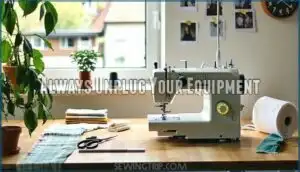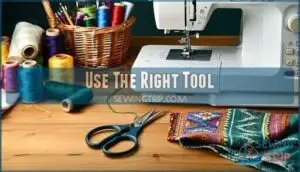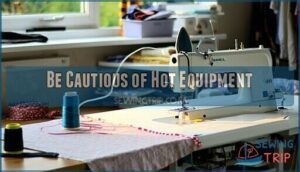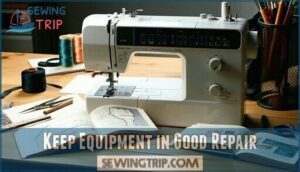This site is supported by our readers. We may earn a commission, at no cost to you, if you purchase through links.
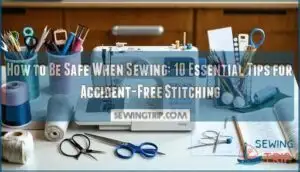
Always unplug your machine before making adjustments, and use proper lighting to see your work clearly.
Sharp scissors and well-maintained tools prevent accidents better than dull ones.
Take regular breaks to avoid repetitive strain, and test iron temperatures on scrap fabric first.
Store cutting tools with blade guards, use magnetic holders for pins, and dispose of broken needles in rigid containers.
Pay attention to needle placement and maintain good posture throughout your projects.
These foundational habits transform potential hazards into manageable elements of your creative process, setting the stage for techniques that’ll keep you stitching safely for years to come, by following complete concepts and maintaining a safe environment.
Table Of Contents
Key Takeaways
- Keep your workspace organized and well-lit – You’ll prevent accidents by maintaining clear surfaces, using proper lighting, and storing cutting tools with blade guards when not in use.
- Always unplug your sewing machine before adjustments – You can’t get shocked or accidentally start the machine while cleaning, threading, or making repairs if it’s unplugged.
- Use sharp, well-maintained tools and replace worn needles – Sharp scissors and fresh needles give you better control and require less force, reducing your risk of slips and injuries.
- Take regular breaks and maintain good posture – You’ll avoid repetitive strain injuries by stepping away every 30-45 minutes, stretching your hands and neck, and keeping your workspace at a proper height.
Start Slow
A gentle start is your best friend when sitting down at the sewing machine. Beginner tips always highlight the importance of a slow pace—think of easing into basic stitches like you’re learning to ride a bike, training wheels and all.
Don’t rush the initial setup; make sure your workspace is organized for safety and prevention. Tie up hair, keep sleeves short, and double-check machine settings before you press the pedal.
Taking it slow gives you solid control as well as a simple sewing injury prevention strategy. Focusing on gentle learning and mindful pace sets the tone for sewing machine safety and builds habits that last through every project.
Keep Your Eyes on Your Work
Once you’re comfortable with the basics, it’s time to hone your focus techniques. Keeping your eyes on your work is a top priority for sewing eye protection and sewing safety tips.
Distractions can lead to sewing accidents before you know it. Make mindful sewing second nature by following five simple steps:
- Always use workspace lighting that lets you see clearly—good light is your best friend.
- Choose fabrics that are easy to handle for your project, reducing strain and sewing hazard control headaches.
- Pay attention to needle and pin placement for sewing injury prevention.
- Use sharp scissors made for fabric to avoid fraying and mishaps.
- Stick with proven attention strategies, pausing briefly to review your work and adjust as needed.
Staying focused helps prevent accidents and keeps your stitches sharp. By following essential safety tips guidelines, sewers can minimize risks and guarantee a safe sewing experience.
Always Unplug Your Equipment
Whenever you’re working with your sewing machine, don’t forget to unplug it before making any adjustments or giving it a good cleaning. It just takes a second, but this habit keeps you away from electrical safety risks, and makes maintenance so much easier.
Tying back your hair and removing jewelry lessens the chance of entanglement too. Treat the power cord like a lifeline—never yank it out or let it twist.
- Check plug security and avoid loose connections.
- Store cords properly to prevent trips and fraying.
- Keep liquids far from the power source to avoid shocks.
Safe habits make sewing enjoyable, and following these tips ensures a good cleaning and maintenance routine.
Use The Right Tool
Using the correct tool for each sewing task prevents injuries and guarantees better results.
You’ll want to choose sharp, well-maintained scissors for fabric cutting and the right bodkin for threading tasks rather than improvising with unsuitable alternatives.
Scissors
Sharp scissors matter more than you think. Dull blades require extra force, creating cutting hazards and reducing your control over fabric.
Choose ergonomic handle design that fits your grip comfortably – your hands will thank you after long projects. Quality sewing scissors with titanium-coated blades stay sharper longer, ensuring clean cuts every time.
Always cut away from your body and pass scissors handle-first to others. Store them with blade guards or protective sheaths to prevent accidents.
Sharp tool safety starts with respecting your scissors as precision instruments, not household tools. Following proper safety practices is essential for a safe sewing experience.
Bodkin
Beyond scissors, bodkins represent one of the smartest sewing aids for needle safety precautions.
These specialized threaders replace dangerous safety pins when threading elastic through casings, eliminating needle stick prevention concerns. A quality bodkin grips elastic securely without twisting, making drawstring replacement effortless.
Here’s why bodkins matter for sewing needle protection:
- Eliminates puncture risks – No sharp pins opening unexpectedly
- Reduces hand strain – Smooth threading without forcing fabric guides
- Prevents fabric damage – Blunt tips won’t snag delicate materials
- Locks securely – Sliding mechanisms guarantee reliable grip
Smart sewers keep bodkins handy for sewing finger safety. These needle threads helpers work perfectly for waistbands, hoodies, and bag drawstrings.
While very narrow hems might need alternative approaches, bodkins handle most threading tasks safely and efficiently, protecting your hands while streamlining your workflow. For superior results, consider using a sewing bodkin tool to guarantee professional-grade stitching.
Store Cutting Tools Properly
Within your sewing sanctuary, proper sharp tool handling transforms chaos into control. Create designated homes for your cutting instruments using protective blade guards and secure storage containers.
Never leave scissors open on your work surface – closing blades after each use prevents nasty surprises when reaching for supplies. Magnetic strips keep rotary cutters organized while protective sheaths shield scissor tips from damage and fingers from harm.
Establish a "one cut, one home" rule for fabric cutting safety. Return each tool to its designated spot immediately after use. This simple habit prevents accidents and extends tool life.
Consider drawer organizers with individual compartments for different cutting precautions. Label storage areas to maintain organization over time. Using effective scissor guard systems is vital for maintaining a safe workspace.
Your future self will thank you when sharp objects aren’t lurking beneath fabric scraps. Proper tool storage isn’t just about organization – it’s about creating a workspace where creativity flows without fear of injury.
Take Breaks
Every thirty to forty-five minutes, step away from your sewing machine for proper rest intervals. Your body wasn’t designed for marathon stitching sessions, and ignoring this fact leads to repetitive strain injuries that can sideline your projects for weeks.
Break times aren’t just about stretching your legs—they’re essential for fatigue prevention and maintaining sharp focus. Use these moments for posture checks, adjusting your chair height and ensuring your shoulders aren’t hunched forward.
Roll your neck gently and stretch your wrists to counteract repetitive motions. Don’t forget eye care during breaks. Look away from your work and focus on something distant to relax eye muscles strained from detailed stitching.
Following proper sewing ergonomics tips and incorporating health and wellness tips into your routine transforms exhausting sewing marathons into enjoyable, sustainable crafting sessions. Your future self will thank you for practicing good sewing posture advice.
Be Cautious of Hot Equipment
Hot equipment in your sewing room demands the same respect as a loaded weapon—one moment of carelessness can leave lasting scars. Electric irons cause over 50 reported burn injuries annually, with 84% of pediatric cases involving children under four who touched cooling equipment.
Iron Safety and Heat Protection:
- Test iron temperature on scrap fabric, never with fingers
- Place hot irons upright on heel rests, not flat surfaces
- Unplug immediately after use by pulling the plug, not cord
- Keep hands dry when handling heated equipment
Burn Prevention measures include: Always store hot tools on heat-resistant surfaces away from traffic zones. Children face higher burn risks—restrict their access while equipment cools. Even "off" irons stay dangerously hot for extended periods, accounting for 25% of accidents.
For electrical safety precautions, inspect cords regularly for damage that could cause overheating. Proper sewing machine safety extends to all heated accessories. Following these sewing safety tips and maintaining equipment guards protects you from preventable injuries. Understanding burn injury causes is essential for effective prevention strategies.
Keep Equipment in Good Repair
Just as hot equipment can cause unexpected burns, malfunctioning machinery poses serious risks that you can easily prevent with proper maintenance.
Your sewing machine isn’t just a tool—it’s a precision instrument that demands respect and care. Think of machine maintenance as an insurance policy against accidents.
Regular equipment checks help you spot problems before they become dangerous. A loose needle clamp can send needles flying. Worn belts might snap unexpectedly. Frayed cords create fire hazards.
Start with weekly visual inspections. Check for loose screws, damaged cords, and unusual noises during operation. Monthly, clean lint from the bobbin area and oil moving parts according to your manual’s sewing machine maintenance schedule.
Replace worn needles immediately—they cause fabric snags and potential injuries. Professional servicing every 12-18 months keeps safety features functioning properly.
A well-maintained machine operates smoothly, reducing strain on your hands and preventing sudden malfunctions that could cause injury. Remember, repair tips from your manual aren’t suggestions—they’re your roadmap to safe sewing.
Handle Needles and Pins Safely
Sharp tool handling requires constant attention to prevent needle puncture injuries. Use magnetic holders to keep needles organized and off work surfaces—they prevent 60% of puncture injuries by securing pins safely. Always store needles in labeled containers rather than loose piles.
Never put pins in your mouth; this creates choking hazards and bacterial infections. Invest in needle guards and thimble use for finger protection during detailed work. These simple tools reduce needle stick prevention incidents by providing barriers between your skin and sharp points.
When disposing broken needles, use rigid containers like old pill bottles for sharp disposal safety. Keep a wrist pincushion nearby for quick pin storage during active sewing. This needle area safety practice prevents dropped pins from becoming stepping hazards.
Change bent or damaged needles immediately—they break unexpectedly and can become dangerous projectiles.
Ensure a Safe Sewing Space
Beyond proper needle and pin handling, your sewing workspace safety matters just as much. A well-organized environment prevents accidents before they happen.
Workspace Cleanup keeps your area hazard-free. Clear surfaces reduce tool-dropping risks, while proper storage solutions keep sharp objects contained. Sewing room organization isn’t just about aesthetics—it’s about preventing injuries from scattered supplies.
Ergonomic workspace setup protects your body during long projects. Position your machine at elbow height and use a chair with lumbar support. Poor posture causes 86% of sewing operators to experience back pain weekly.
Lighting safety prevents eye strain and costly mistakes. Position task lights to eliminate shadows on your work surface. Adequate lighting reduces accident risk by 60%. Proper room lighting systems are essential for a safe workspace.
- Cable management prevents tripping hazards—secure loose cords and avoid overloading outlets.
Sewing workspace safety includes keeping pets and children away from your area. Tie back long hair and remove loose jewelry that could catch in moving parts. Your sewing space organization should prioritize both efficiency and protection.
Frequently Asked Questions (FAQs)
What are some common sewing machine safety hazards?
Common sewing machine hazards include needle punctures, getting fingers caught in moving parts.
Electrical shock from damaged cords, fabric jams causing sudden machine movements, are also significant hazards.
Poor posture leading to repetitive strain injuries is another key concern related to sewing machine use.
How can I prevent distractions while sewing?
Keep your workspace organized and free of clutter.
Turn off phones and notifications.
Secure loose hair, clothing, and jewelry.
Keep children and pets away from your sewing area to maintain focus and prevent accidents.
What are some tips for safely storing cutting tools?
Scissors and rotary cutter cuts cause significant injuries during fabric prep.
Always use protective sheaths on scissors, store them in designated containers, and keep cutting tools away from your workspace when not actively using them.
Keep them in designated containers, and ensure you store scissors properly to prevent accidents.
How often should I change my sewing machine needle?
You should change your sewing machine needle after every 8-16 hours of sewing or when switching fabric types.
Dull needles cause skipped stitches, fabric damage, and thread breakage, compromising both your project quality and machine safety, which can be prevented by using a new needle, thus avoiding fabric damage.
Should I wear protective clothing while sewing?
Yes, you should wear appropriate protective clothing while sewing.
Avoid loose sleeves, dangling jewelry, and flowing scarves that could catch in machine parts.
Tie back long hair and consider using a thimble to protect your fingertips during hand sewing.
How do I prevent electrical hazards safely?
Always unplug your machine before cleaning, oiling, or troubleshooting to prevent accidental starts. Manage cords carefully to avoid tripping hazards, and never overload outlets with multiple devices.
What should I do about fabric fumes?
Make good ventilation when working with synthetic fabrics or treated materials. Open windows, use fans, or work outdoors to avoid inhaling potentially harmful chemical vapors from certain textiles.
How can I protect my eyes properly?
Good lighting prevents eye strain while sewing.
Position your work area near a window or use bright LED task lighting.
Take breaks every 30 minutes to rest your eyes and prevent fatigue.
Is it safe to sew while pregnant?
Sewing during pregnancy is generally safe, but 83% of sewers experience some type of pain from poor posture.
You’ll need extra attention to ergonomics, frequent breaks, and proper seating to avoid back strain during this special time, which can help mitigate the risk of back strain.
Conclusion
Sarah thought she could quickly hem her dress without proper lighting.
The needle pierced through fabric and straight into her finger, sending her to urgent care for stitches.
Don’t let haste compromise your safety.
Master how to be safe when sewing by implementing these essential practices consistently.
Your fingers, eyes, and creative passion deserve protection.
Smart preparation prevents painful accidents and keeps your projects enjoyable rather than hazardous experiences.
- https://www.lendingtree.com/insurance/appliance-injuries-study/
- https://wayne.osu.edu/sites/wayne/files/imce/Safety%20rules.pdf
- https://www.ahschools.us/cms/lib/MN01909485/Centricity/Domain/7165/sewing%20safety%20sheet.doc
- https://www.singersafety.com/best-safety-equipment-for-sewing-centers/
- https://www.reddit.com/r/sewing/comments/omjkrw/protective_gear_for_hands_while_sewing/


